◄ Carnets Geol. 14 (16) ►
Contents
[Introduction] [Geological setting and sampling]
[Taxonomic list of species of nannofossils and foraminifera ...]
[Discussion]
and ... [Bibliographic references]
Laboratorio de Bioestratigrafía, Universidad Nacional de la Patagonia San Juan Bosco, Comodoro Rivadavia, Chubut 9005 (Argentina)
Published online in final form (pdf) on November 14, 2014
[Editor:
Robert W. ; technical editor: Bruno ]
An assemblage of nannofossils from the Salamanca Formation is reported for the first time from the Punta Peligro Norte locality in the San Jorge Gulf Basin, Argentina. Several recognized nannofossils have a stratigraphic distribution within the lower Danian. The assemblage of nannofossils and associated foraminifera is here discussed taking into account biostratigraphic and paleoecological aspects.
Nannofossils; foraminifera; Paleocene; Salamanca Formation; San Jorge Gulf Basin.
M. (2014).- Nannofossils and foraminifera from the Salamanca Formation (Paleocene) in Punta Peligro Norte (Chubut, Argentina).- Carnets de Géologie [Notebooks on Geology], Brest, vol. 14, nº 16, p. 343-349.
Nannofossiles et foraminifères de la Formation Salamanca (Paléocène) à Punta Peligro Norte (Chubut, Argentine).- Une association de nannofossiles de la Formation Salamanca est signalée pour la première fois dans la localité de Punta Peligro Norte dans le Bassin du Golfo San Jorge en Argentine. Plusieurs nannofossiles identifiés ont une extension stratigraphique limitée au Danien inférieur. L'association, qui comporte des nannofossiles mais aussi des foraminifères, est discutée en prenant en considération les aspects biostratigraphiques et paléoécologiques.
Nannofossiles ; foraminifères ; Paléocène ; Formation de Salamanca ; Bassin du Golfo San Jorge.
Nanofósiles y Foraminíferos de la Formación Salamanca (Paleoceno) en Punta Peligro Norte (Chubut, Argentina).- Se da a conocer por primera vez una asociación de nanofósiles procedente de la Formación Salamanca en la localidad de Punta Peligro Norte, Cuenca del Golfo San Jorge. Algunos de los nanofósiles reconocidos tienen una distribución estratigráfica dentro del Daniano inicial. La asociación de nanofósiles y los foraminíferos asociados se discuten tomando en cuenta aspectos bioestratigráficos y paleoecológicos.
Nanofósiles; foraminíferos; Paleoceno; Formación Salamanca; Cuenca del Golfo San Jorge.
The present contribution deals with nannofossils and foraminifera from the Salamanca Formation, at the Punta Peligro Norte locality (45°30' S, 67°11' W), 45 kilometers north of Comodoro Rivadavia City, San Jorge Gulf Basin (Fig. 1 ![]() ). Previous micropaleontological studies from different outcrops of the Salamanca Formation including foraminifera, suggested a Paleocene age for the unit (see among others ,
1966; , 1967; ,
1975a, 1975b; et al.,
2014). However, a nannofossil assemblage with Arkangelskiella cymbiformis , 1959, was reported from the subsoil in the centre of the basin, suggesting a Maastrichtian age for the lower levels of the studied unit ( et al.,
1989). Recently, et al.
(2014) reported a multi-disciplinary geochronologic study of the Salamanca Formation in the western part of the basin with scarce nannofossils indicating an early Danian age.
). Previous micropaleontological studies from different outcrops of the Salamanca Formation including foraminifera, suggested a Paleocene age for the unit (see among others ,
1966; , 1967; ,
1975a, 1975b; et al.,
2014). However, a nannofossil assemblage with Arkangelskiella cymbiformis , 1959, was reported from the subsoil in the centre of the basin, suggesting a Maastrichtian age for the lower levels of the studied unit ( et al.,
1989). Recently, et al.
(2014) reported a multi-disciplinary geochronologic study of the Salamanca Formation in the western part of the basin with scarce nannofossils indicating an early Danian age.
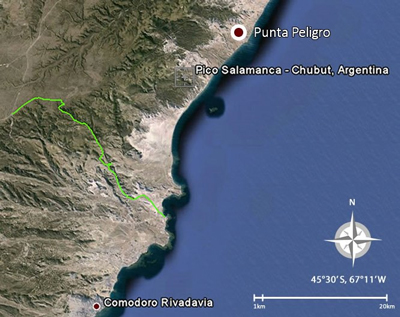
Click on thumbnail to enlarge the image.
Figure 1:
Satellite image showing the location of Punta Peligro Norte locality (Chubut
Province, Argentina).
[Some rights reserved: Image © 2014 DigitalGlobe - Data SIO NOAA, U.S. Navy,
NGA, GEBCO - © 2014 Google, Inav/Geosistemas SRL].
Editorial note: "The authors are the 'sole responsible'
for the usage made of texts, illustrations (tables and drawings), photos and
videos provided and used in their respective publications."
The well preserved nannofossil assemblage presented here comes from the lower horizons of the Salamanca Formation at Punta Peligro Norte (Fig.
2.A ![]() ). This assemblage includes some taxa restricted to the lower Danian biostratigraphic unit NNTp2 Cyclagelosphaera alta Zone (,
1999), partially correlated with the NP1-NP3 Zone (, 1971) and the CP1A-CP2 Zone ( & ,
1980).
). This assemblage includes some taxa restricted to the lower Danian biostratigraphic unit NNTp2 Cyclagelosphaera alta Zone (,
1999), partially correlated with the NP1-NP3 Zone (, 1971) and the CP1A-CP2 Zone ( & ,
1980).
| A | 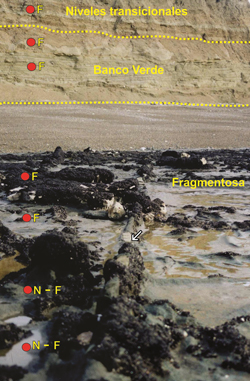 |
B | 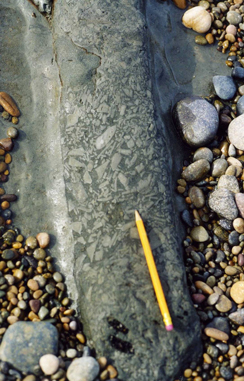 |
Click on thumbnail to enlarge the image.
Figure 2: A: Panoramic view of the Salamanca Formation at Punta Peligro Norte, indicating the productive levels [N: nannofossils, F: foraminifera] and showing B: A detail of the clastic dike in the Fragmentosa horizon (arrow on A).
The Salamanca Formation ( & , 1972) is the basal unit of the Cenozoic succession of the San Jorge Gulf Basin. It represents the first Atlantic marine transgression in the basin. The mentioned unit is overlain by continental levels of the Río Chico and the Sarmiento formations, the marine Chenque Formation and the continental Santa Cruz Formation. Finally, the section ends with the deposits of glacio-fluvial origin known as "Rodados Tehuelches".
The Salamanca Formation or "Salamanquense" was divided into four horizons by
(1949): Lignitífero, Glauconítico, Fragmentosa and Banco Verde, which divisions are still used by stratigraphers. At the Punta Peligro Norte locality, the Fragmentosa horizon partially crops out at low tide, and it is overlain by the Banco Verde bed, which in turn, grades transitionally (Niveles transicionales) upwards into the Banco Negro sediments
(transitional levels of et al., 2010):
Fig. 2.A ![]() . Studies of the Banco Negro sediments at different localities have provided remains of turtles, crocodyliforms and a significant mammal fauna (see among others et al.,
1992; et al.,
1993, & ,
1997; & ,
2003; & ,
2009).
. Studies of the Banco Negro sediments at different localities have provided remains of turtles, crocodyliforms and a significant mammal fauna (see among others et al.,
1992; et al.,
1993, & ,
1997; & ,
2003; & ,
2009).
The Fragmentosa and the glauconitic facies (Glauconitico) represent a marine transgression event, referred to as an epicontinental flood by
(2009). The approximate thickness of the outcrop at low tide is about 12 meters including fractured gray and dark gray-green calcareous shale. Upwards, the sandy levels include abundant bioturbation and well preserved shell fragments. Sporadic tabular clastic dikes a few centimeters thick are also observed (Fig.
2.B ![]() ). These dikes were formed by the filling of fissures with dark olive gray sands from the overlying Banco Verde horizon ( & ,
1994). Numerous samples from the Fragmentosa horizon contain a well preserved and moderately diverse association of foraminifera, mostly benthonic, abundant ostracods and well preserved nannofossils, which are recovered exclusively from this horizon. The association of microfossils seems to correspond to a sublittoral platform in a normal marine environment.
). These dikes were formed by the filling of fissures with dark olive gray sands from the overlying Banco Verde horizon ( & ,
1994). Numerous samples from the Fragmentosa horizon contain a well preserved and moderately diverse association of foraminifera, mostly benthonic, abundant ostracods and well preserved nannofossils, which are recovered exclusively from this horizon. The association of microfossils seems to correspond to a sublittoral platform in a normal marine environment.
The Banco Verde unit shows evidence of a marine regression, with 12 meters of sandstone and siltstone including a basal bioruditic breccia. The greenish-pale olive glauconitic sandstones contain abundant fragmented invertebrate remains and a fauna of calcareous microfossils. Many species of foraminifera and ostracods from this level were also recognized in the underlying Fragmentosa horizon. The greatest diversity of the microfossil assemblage is observed in the basal levels of the Banco Verde, decreasing upwards both in variety and number. The samples obtained from the upper levels, show a predominance of ostracods, buliminellas and buliminas. Forty two samples were recovered from the Fragmentosa and Banco Verde horizons, eighteen of them produced microfossils and only three samples included nannofossils.
The present list of taxa follows the systematic scheme of and (1997).
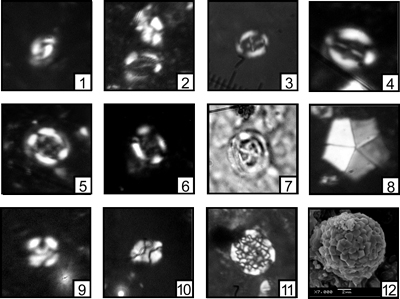
Click on thumbnail to enlarge the image.
Figure 3: Nannofosils from the Fragmentosa horizon: 1. Praeprinsius dimorphosus (5.7µm); 2. Hornibrookina teuriensis (10µm); 3-4. Cruciplacolithus primus (7µm); 5. Cruciplacolithus tenuis (10 µm); 6-7. Chiasmolitus sp. (11µm); 8. Braadurosphaera bigelowi (12µm); 9. Cyclogelosphaera alta (5.7 µm); 10. Neocrepidolithus fossus (7 µm); 11. Thoracosphaera operculata (12.8µm); 12. Thoracosphaera saxea.
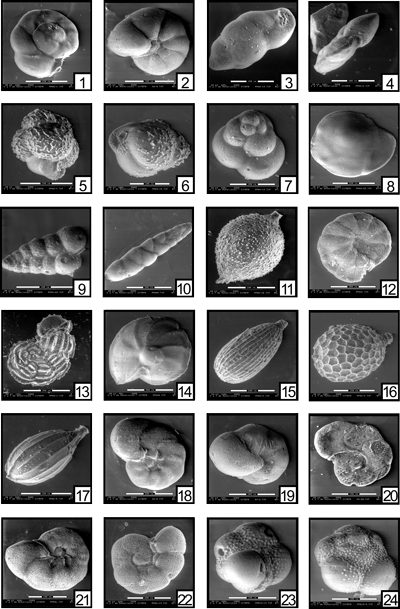
Click on thumbnail to enlarge the image.
Figure 4: Foraminifera from the Fragmentosa and Banco Verde horizons: 1- 2. Gyroidinoides patagonicus; 3. Buliminella isabeliana; 4. Gavelinella midwayensis; 5-6. Bulimina pascuali; 7. Guembelitria sp.; 8. Alabamina midwayensis; 9. Chiloguembelina sp.; 10. Siphogeneroides elegantus; 11. Pseudonodosaria neuquensis; 12. Cyclammina garcilassoi; 13. Lenticulina ulatisensis; 14. Lenticulina rivadaviensis; 15. Lagena archangelsky; 16. Lagena hexagona; 17. Lagena sp.; 18. Discorbinella burlingtonensis; 19. Cibicides cf. Cibicides refulgens; 20. Cibicides sp.; 21-22. ?Echigoina cf. E. hatai; 23-24. Praepararotalia cf. P. cretacea.
The reported microfossil association was recovered from mudstones and sandstones from both the Fragmentosa and Banco Verde horizons. Nannofossils are exclusively from the basal levels of the Fragmentosa horizon. They are scarce but well preserved and the species listed below are restricted to the early Danian interval:
The biostratigraphic importance of Cyclogelosphaera alta is here emphasized because its first occurrence (FO) indicates the base of the NNTp1 Biantholithus hughesii Zone (, 1999), which is correlated with the lower part of NP1 (, 1971) and the CP1A Zone ( & , 1980). Its last occurrence (LO) indicates the top of the NNTp2 Cyclagelosphaera alta Zone (, 1999), which is correlated with the middle part of NP3 (, 1971) and the CP2 Zone ( & , 1980).
Neocrepidolithus fossus is also a biostratigraphic marker whose last occurrence (LO) is used by (1989) to define the top of the Subzone NNTp4C, which is correlated with the middle part of NP4 (, 1971) and the CP3 Zone ( & , 1980). The recognized associated foraminifera do not include species with biostratigraphic significance, but they are useful as paleoecological indicators.
The foraminiferal assemblage is more diverse and abundant in the Fragmentosa horizon. It indicates a shallow platform environment. Several species of Cibicides indicate well-oxygenated water, with a steady supply of food (, 1994).
In turn, the Banco Verde horizon, interpreted as an estuarine environment (, 2009), shows a diverse association only in the basal levels, sharing many microfossil species with the Fragmentosa horizon. However, in the upper part, in the transitional levels to the Banco Negro horizon, the foraminifera are represented mostly by abundant and small specimens of Buliminella and Bulimina. This assemblage also includes ostracods and sponge spicules, and probably indicates specific paleoenvironmental conditions related to the transition into the continental levels of the Banco Negro.
The author dedicates this article to the memory of Professor Eduardo and thanks Dr. Ignacio for reading the manuscript, Dr. Patricia for discussions and suggestions, Esteban and geologist Andrea de for the preparation of the figures. She would like to thank also the reviewers for their careful reading and comments.
C., J.S., V.A. & H.E. (1989).- Cuenca Golfo San Jorge. In: G. & L. (eds.) Cuencas sedimentarias argentinas.- Serie Correlación Geológica, San Miguel de Tucumán, nº 6, p. 319-345.
A. (1972).- Buliminacea y Cassidulinacea (Foraminiferida) guías del Cretácico superior (Maastrichtiano medio) y Terciario inferior (Daniano inferior) de la República Argentina.- Revista Española de Micropaleontología, Madrid, vol. IV, nº 3, p. 327-353.
A. (1975a).- Bioestratigrafía del Paleógeno en la República Argentina.- Revista Española de Micropaleontología, Madrid, vol. VII, nº 3, p. 429-450.
A. (1975b).- Bioestratigrafía del Paleoceno marino en la provincia del Chubut, República Argentina.- 1º Congreso Argentino de Paleontología y Bioestratigrafía (Tucumán, 1974), Actas 2, p. 271-316.
E., G. & S. (1980).- Atlas of benthic shelf foraminífera of the Southwest Atlantic.- Dr W. Junk b.v. Publishers, The Hague, 147 p. (reference used to aid the identification).
J.F., M.N. & A. (1993).- La fauna local de Punta Peligro, Paleoceno Inferior de la provincia del Chubut, Patagonia, Argentina.- Evolutionary Monographs, Chicago, vol. 14, 62 p.
J.F. & J. (1997).- Un primitivo Notonychopidae (Litopterna) del Paleoceno inferior de Punta Peligro, Chubut, Argentina.- Estudios Geológicos, Madrid, vol. 53, nº 5-6, p. 263-274.
W., P., A., R.L., T., P.K., T.J., H., E.M., B.T., M., B R., J.M., J.D., B.S., M.S., M.D., A. & M.C. (2014).- New age constraints for the Salamanca Formation and lower Río Chico Group in the western San Jorge Basin, Patagonia, Argentina: Implications for Cretaceous-Paleogene extinction recovery and land mammal age correlations.- Geological Society of America, Bulletin, Tulsa, vol. 126, nº 3-4, p. 289-306.
E. (1949).- Descripción geológica de la Patagonia.- Dirección General de Yacimientos Petrolíferos Fiscales, Buenos Aires, vol. 2, 349 p.
N. (2009).- Tectónica y sedimentación del registro paleógeno (Formaciones Salamanca y Río Chico), Cuenca del Golfo San Jorge, Argentina.- Tesis doctoral, Universidad Nacional de la Patagonia San Juan Bosco, 313 p.
A.M. & A.G. (2003).- A femur of a monotreme (Mammalia, Monotremata) from the Early Paleocene Salamanca Formation of Patagonia, Argentina.- Ameghiniana, Buenos Aires, vol. 40, nº 4, p. 625-630.
A.M. & G.W. (2009).- Additional data on early Paleocene metatherians (Mammalia) from Punta Peligro (Salamanca Formation, Argentina): comments based on petrosal morphology.- Journal of Zoological Systematics and Evolutionary Research, Frankfurt am Main, vol. 47, nº 4, p. 391-398.
W.W., H.P., P.H., R.R. & J.E. (1967).- Calcareous nannoplankton zonation of the Cenozoic of the gulf Coast and Caribbean-Antillean area, and transoceanic correlation.- Transactions of the Gulf Coast Association of Geological Societies, San Antonio, vol. 17, p. 428-480.
K. (1994).- Benthic foraminiferal dissolved-oxygen index and dissolved-oxygen levels in the modern ocean.- Geology, Boulder, vol. 22, nº 8, p. 719-722.
L. & M.A. (1994).- Asociaciones de fósiles y hiatos en el Supracretácico-Neógeno de la Patagonia: Una perspectiva estratigráfico-secuencial.- Ameghiniana, Buenos Aires, vol. 31, nº 3, p. 257-281.
P. & R. (1972).- Región Extraandina del Chubut y norte de Santa Cruz. In: A.F. (ed.), Geología regional argentina.- Academia Nacional de Ciencias, Córdoba, p. 601-654.
C., R.K. & B.T. (1998).- A benthic paleohabitat for Praepararotalia gen. nov. and Antarcticella & .- Journal of Foraminiferal Research, Lawrence, vol. 28, p. 3-18.
V. (1967).- Estratigrafía del Rocanense del Puesto Alvarez, curso inferior del Río Chico, Provincia del Chubut.- Revista del Museo de La Plata, (nueva serie: Paleontología), tomo V, p. 197-258.
I. (1966).- Foraminíferos, edad y correlación estratigráfica del Salamanquense de Punta Peligro (45°30' S, 67°11' W) Provincia de Chubut.- Revista Asociación Geológica Argentina, Buenos Aires, vol. 21, nº 2, 127-157.
H. & D. (1980).- Supplementary modifications and introduction of code numbers to the low-latitude coccolith bioestratigarphic zone.- Marine Micropaleontology, Amsterdam, vol. 5, p. 321-325.
R., M., E., J.L., H. & S.J. (1992).- First discovery of monotremes in South America.- Nature, London, vol. 356, p. 704-705.
K. (1985a).- 10 Mesozoic calcareous nannofossils. In: H.H., J.B. & K. (eds.), Plankton stratigraphy.- Cambridge University Press, p. 329-426 (reference used to aid the identification).
K. (1985b).- 11. Cenozoic calcareous nannofossils. In: H.H., J.B. & K. (eds.), Plankton stratigraphy.- Cambridge University Press, p. 427-554 (reference used to aid the identification).
J.P. & G.N. (2006).- Nannofósiles calcáreos del Cretácico tardío-Terciario, del Pozo BB III A x-1 (Bahía Blanca), cuenca del Colorado, Argentina.- Ameghiniana, Buenos Aires, vol. 43, nº 3, p. 557 (reference used to aid the identification).
J.P. (2009).- Nannofósiles calcáreos del sudeste de la provincia de Santa Cruz, Patagonia, Argentina.- Ameghiniana, Buenos Aires, vol. 46, nº 2, p. 273-284 (reference used to aid the identification).
M.S., J.M., E. & S.D. (2010).- Redefinición estratigráfica del Grupo Río Chico (Paleógeno inferior), en el norte de la Cuenca del Golfo San Jorge, Chubut.- Revista de la Asociación Geológica Argentina, Buenos Aires, vol. 67, nº 2, p. 239-256.
O. (1999).- Paleogene. In: P.R. (ed.), Calcareous nannofossil biostratigraphy.- University College London, p. 200-224.
J.R. & P.R. (1997).- Cenozoic calcareous nannoplankton classification.- Journal of Nannoplankton Research, London, vol. 19, p. 36-47.